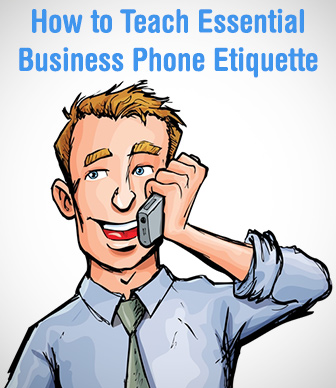Don’t Answer the Office Phone with “Hey”: Teaching Essential Business Phone Etiquette


Usually when it rings it turns out to be a wrong number, not many people being interested in calling the staff room for ESL teachers, so I ignored it. However, it went on ringing for so long that I finally picked it up. A young woman on the other end asked to speak to Denise, another ESL instructor. I told her Denise wasn’t around and began to hang up, late now for class, but the other woman asked to leave a message. Seriously annoyed now, I suggested she contact Denise’s cell phone and was told Denise didn’t have a cell phone. So I grudgingly took the message and gave it to Denise when I saw her after class.
“What was she calling about, did she say?” Denise asked, looking down at the message.
“No. I forgot to ask.”
Forgot to ask? How did that happen—I, who had answered a switchboard at a major department store for four years through college and prided myself on my perfect telephone messages, forgot to ask why the caller was calling?
It was then it occurred to me that taking a phone message is something of a lost—if still necessary—art. It will not impress the boss if an employee leaves the name off of a message or forgets to ask why the caller called.

Sometimes even native English speakers will forget important information in a phone message: my husband, for example, recently reported that “someone” had called about the party at our house that weekend. So here follow the important components of a message:
Get the first and last names; remember the recipient of the message might know several “Tom’s.” Get the organization the caller is associated with or how he or she is connected to the callee. Get the correct spelling of the name. All of this may be important for the recipient of the message: he or she may not immediately recollect to who “Tom Anderson” is, until she learns of her connection to him, the planning committee for the staff holiday party.
Get the full phone number, including area code and country code as necessary. Get an email address as well as necessary. All of this information may be necessary for a call back if the caller lives out of the area or if his phone is busy when the call is returned.
If the message taker gets a brief reason for the caller contacting the callee, this can save embarrassment on both of their parts, such as the following conversation demonstrates, “Tom, this is Debbie. I’m returning your call.” “Oh, yeah.” (Long pause). “How can I help you, Tom? It doesn’t say on the message.” “Oh. Well, right now I don’t remember why I called, to tell the truth…” and so on.
This is in case the person who receives the message has questions about it, and there are several other members of the household or the office, so the recipient of the message knows who to go to with questions.

Go over a typical message on the board or screen with the students, pointing out the important parts of the message. Point out that good telephone messages are both brief and complete: “concise,” a word meaning both brief and meaningful, is an important value in written communication in English in general that you might teach students.
First model leaving a message by playing the role of the caller while also taking down the message on the board. Demonstrate important questions to ask for the message: e.g., “Who is calling?” “What is this regarding?” and so forth so that students can see both the important questions to ask and what to note down. Then get a couple of student volunteers to leave simple messages, perhaps for other students in the class, while you take the messages on the board.
Now that the students have seen how a message is left and taken in English, they are ready to practice as a class through dictation. The teacher can “leave” a simple message and all of the students “take” it. As time and level permits, the instructor might want to leave several messages. Students can then compare their papers with the classmates seated next them for accuracy and completeness before the instructor goes over the messages on the board.
After practicing as a whole class, now have students break into pairs. Give out index cards with the callee’s name and the message: students then role play leaving and taking the messages, switching roles so that they learn both. They may also simply make up their own messages instead of using the index cards if they desire. Play phones or old unused phones may be brought in for this step.
As a last step, have students practice outside of class: call and leave messages for roommates, for example, if many of them share the same dorm or live near each other. They may make up the reasons for the call or may have an actual reason for the call, as long as they have to give the message to someone other than the person who answers the phone, and they have some reason—real or imaginary—that they have already thought of before calling. This simulates a real telephone situation in which a caller has to be somewhat prepared before calling.
However, these pitfalls can be avoided if students learn to both take and leave messages appropriately.